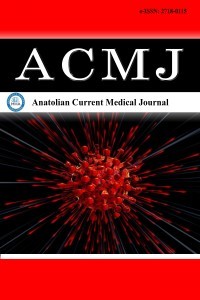
Anatolian Current Medical Journal
Yazarlar: ["Özgül SOYSAL GÜNDÜZ", "Kezban ARMAGAN"]
Konular:-
DOI:10.38053/acmj.1132856
Anahtar Kelimeler:Systemic sclerosis,Cardiovascular mortality,QT dispersion
Özet: Introduction: Cardiac arrhythmias and sudden death may occur as a result of ventricular myocardial fibrosis or ischemia in patients with systemic sclerosis (SSc). QT prolongation and QT dispersion, which facilitate the development of ventricular fibrillation, are important cardiac problems associated with increased mortality. In this study, we aimed to investigate the prevalence of corrected QT dispersion (cQTD) and related factors in our patients with systemic sclerosis compared to healthy controls. Material and Method: The 12-lead electrocardiograms with a rate of 25 mm/s of patients with no previous history of cardiovascular disease and controls were analyzed. cQTD was defined as the difference between the maximum QT interval and the minimum QT interval. Nailfold capillaroscopy examination was performed. Disease activity was evaluated using revised European Scleroderma Study Group activity index. Results: Forty-nine SSc patients (45 females, mean age 53.26±10.63 years, and disease duration 8.0 (1-25) years) and 41 controls (37 females, mean age 49.29±8.02 years) were included. While the frequency of smoking was significantly higher in controls (p=0.025), erythrocyte sedimentation rate was higher in patients (p<0.001). cQTD was significantly higher in the patient group compared to the control group (65.14±17.57 ms and 42.73±10.03 ms, respectively, p<0.001). A significant positive correlation was found between erythrocyte sedimentation rate and cQTD in the patient group. We found no association between cQTD and disease activity, medications, anti-SSA/Ro positivity, capillaroscopy paterns, presence of interstitial lung disease and pulmonary arterial hypertension. Conclusion: In our study, cQTD, which indicates an increased risk for ventricular arrhythmia and cardiovascular mortality, was found to be significantly higher in the patients compared to the controls. Determining cardiac risks with an electrocardiogram, which is a non-invasive and easily available method, is important in the follow-up of SSc patients.